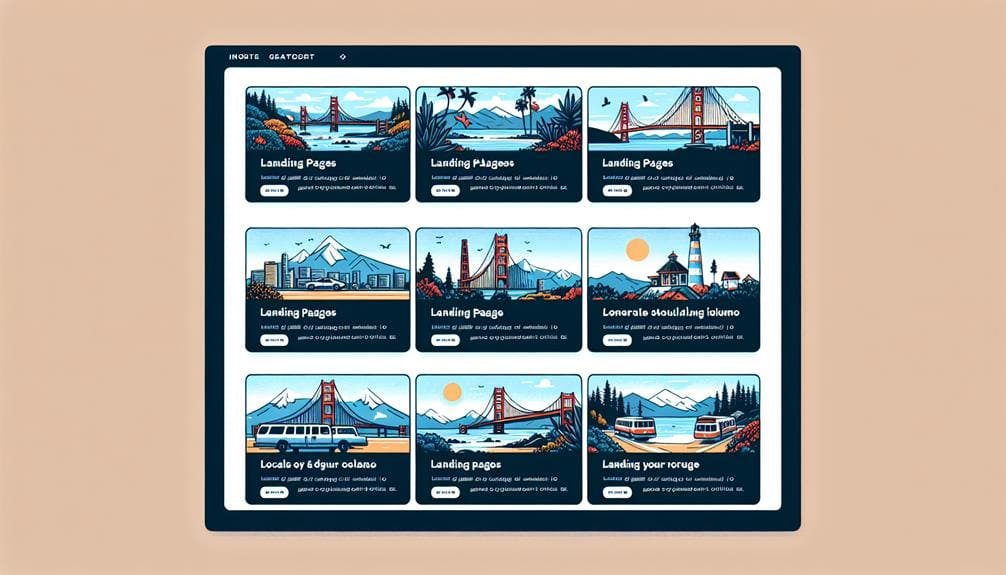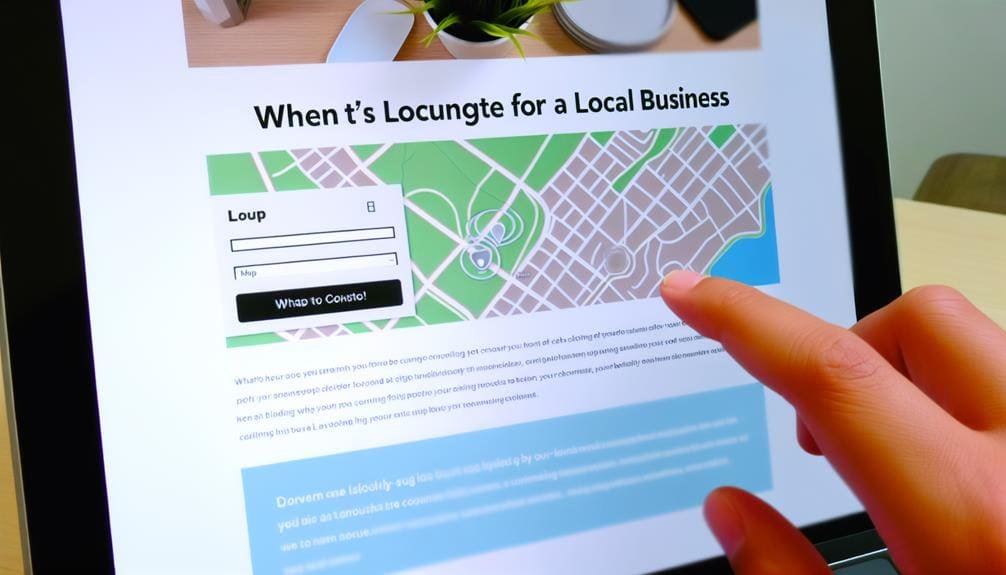Top 10 Multi-Location Landing Page Strategies
January 19, 2024 | by Jacob Cavazos

When it comes to multi-location landing pages, it's like having a well-organized, visually appealing map that guides potential customers straight to your business's doorstep. With the right strategies in place, these pages can become powerful tools for boosting online visibility and driving foot traffic to each location. But what are the top 10 strategies that can elevate these pages from merely functional to highly effective? Well, buckle up, because we're about to uncover the key tactics that can take your multi-location landing pages to the next level, helping you stand out in local searches and capture the attention of nearby customers.
Content Duplication Prevention
To prevent content duplication on multi-location landing pages, it is crucial to craft unique and valuable content for each local page rather than simply swapping out the city name. Duplicate content can harm local SEO efforts, as Google may consider it as doorway pages. Instead, focus on creating distinct, high-quality content for each location page. When optimizing landing pages for multiple locations, it's essential to avoid keyword stuffing and overuse. Utilize subtle clues to indicate the page's topic, and refrain from using keyword-stuffed H1 headings to prevent content spamming. The goal is to provide users with helpful and relevant information while ensuring that each local landing page offers unique value. By doing so, you can boost local business listings and enhance the visibility of your Google Business Profiles. Ultimately, the emphasis should be on creating local landing pages that not only avoid duplicate content but also serve as valuable resources for users in specific locations. This approach will contribute to a successful local SEO strategy and improve the overall performance of location pages.
Strategic Content Optimization
We know that strategic content optimization is crucial for multi-location landing pages. By strategically placing keywords, creating a visual hierarchy, and matching user intent, we can enhance the relevance and effectiveness of our content. This approach not only improves search optimization but also ensures that our landing pages effectively cater to the needs and interests of our local audiences.
Keyword Placement
Strategically placing keywords throughout your multi-location landing pages can significantly impact their visibility and effectiveness in reaching your target audience. When optimizing keyword placement on local landing pages, it's crucial to:
- Use unique and helpful content for each location to avoid duplicate content and content spamming, ensuring that each page provides valuable information tailored to the specific area.
- Avoid keyword stuffing by integrating keywords naturally within the content, headers, and meta tags, enhancing SEO without jeopardizing the user experience.
- Provide subtle clues for Google to understand the page's topic, such as incorporating details about your business that relate to the targeted location, helping search engines associate the content with the relevant area.
Visual Hierarchy
Utilizing strategic content optimization allows for the establishment of a clear visual hierarchy on multi-location landing pages, guiding users' attention to prioritize important information through effective design elements and content organization. By using larger fonts, bold colors, and strategic placement, we can direct users towards essential content. Organizing information in alignment with the user's natural reading pattern ensures that they are led from the most important to the least important content. Visual cues such as arrows, icons, or contrasting colors can draw attention to specific elements or calls to action, further enhancing the visual hierarchy. Additionally, incorporating clear and concise headings, subheadings, and bullet points aids in breaking up content for easy scanning. Employing these visual hierarchy strategies not only improves the user experience but also boosts your local SEO efforts, ultimately leading to enhanced local SEO results.
User Intent Matching
To effectively match user intent, it is essential to incorporate subtle cues and relevant content without resorting to keyword stuffing or spammy tactics on local landing pages. When optimizing for user intent matching on landing pages for multiple locations, consider the following strategies:
- Create location-specific information and content that relates to the targeted area, including community history, local amenities, and case studies or work examples from different cities.
- Take original photos of the locality, including local landmarks, parks, and community events, to demonstrate local community involvement.
- Highlight local charities and organizations on city-specific pages, including their logos and information, and seek reciprocal links or mentions on their websites.
URL and Image Optimization
Optimizing URLs and images is crucial for improving search rankings and enhancing user experience across multiple locations. By adhering to SEO best practices for URLs, such as keeping them concise, including relevant keywords and city names, and using hyphens to separate words, landing pages can better cater to local search queries. Similarly, renaming images with descriptive titles that include location-specific keywords, and adding alt tags with relevant descriptions, can significantly improve online visibility and user engagement. Incorporating location-specific information in URLs and images is essential for tailoring content to the targeted audience in each area, thereby boosting local search rankings and Google Business Profile visibility. Below is a table summarizing the key components of URL and image optimization for multi-location landing pages:
| Aspect | Description | Importance |
|---|---|---|
| URL Structure | Keep it short, include product/service and city, use hyphens to separate words | High |
| Image Optimization | Rename with meaningful descriptions, include city name, add alt tags with relevant keywords and descriptions | High |
| Location-Specific Content | Incorporate area-specific information in URLs and images to cater to targeted local audience | High |
| SEO Impact | Boost local search rankings, improve Google Business Profile visibility | High |
| User Experience Enhancement | Enhance online visibility and user engagement | High |
Location-Specific Business Information

Incorporating location-specific business information into multi-location landing pages builds upon the foundation of URL and image optimization, enhancing the relevance and appeal of the content to targeted local audiences. By integrating business information tailored to each location, we can significantly improve the effectiveness of our landing pages in attracting and converting local visitors. Here are three key ways location-specific business information contributes to the success of multi-location landing pages:
- Enhanced Local Relevance: Including specific details such as addresses, phone numbers, and business hours helps to establish the local relevance of the landing page, making it more appealing to users in the targeted area.
- Improved Google Business Profile (GBP) Performance: Providing accurate and comprehensive business information on local pages can positively impact the performance of the GBP, increasing visibility in mobile search results and attracting potential customers.
- Boosted Local SEO with Structured Data: Incorporating structured data markup to highlight location information can enhance the visibility of the landing pages in local search results, contributing to improved local SEO performance.
Original Locality Photography
We've found that using original photos of the locality can significantly enhance the visual appeal of landing pages. By capturing local landmarks, parks, and community events, businesses can showcase their connection to the community. This not only adds authenticity but also boosts geographic relevance, making the landing page more engaging and trustworthy.
Localized Image Selection
Utilizing original locality photography for image selection can significantly enhance the authenticity and relevance of multi-location landing pages. When focusing on localized image selection, it's crucial to consider several key factors:
- Authentic Representation: Original locality photography provides unique details and genuine depictions of each location, resonating with potential customers seeking local businesses.
- Improved Online Visibility: Incorporating localized images can positively impact local listings and search engine results, attracting more organic traffic and enhancing digital marketing efforts.
- Enhanced Credibility: Localized image selection can boost online reviews and customer trust, as it demonstrates a commitment to showcasing each location accurately.
Authentic Visual Content
When crafting multi-location landing pages, incorporating original locality photography for authentic visual content is essential for enhancing the localized customer experience and driving organic traffic. Original locality photography not only adds credibility and authenticity but also provides a unique glimpse into each location, resonating with local audiences. According to Google, pages with images receive 94% more views, making it a crucial element for engaging content. Furthermore, original locality photography aids in local SEO efforts, as it provides valuable context for search engines, enhancing the likelihood of appearing in local searches and Google My Business listings. Additionally, authentic visual content can serve as social proof, building trust with potential customers. Including images of storefronts, interiors, and driving directions can further improve the user experience and encourage foot traffic.
Geographic Relevance
To further emphasize the local connection and enhance the customer experience, incorporating original locality photography for geographic relevance is paramount when creating multi-location landing pages. When it comes to geographic relevance, utilizing original locality photography offers several benefits:
- Showcase the uniqueness of each location through original photography capturing local landmarks, events, and community involvement.
- Use original images instead of stock photos to demonstrate your business's connection to the local community.
- Optimize the photos for search purposes to enhance the geographical relevance of your landing pages.
Local Community Engagement
Engaging with the local community through highlighting local charities, organizations, and events on landing pages demonstrates our genuine involvement and support, fostering a sense of connection and trust with the local audience. Incorporating location-specific information on landing pages, such as local amenities, history, and community relevance, resonates with the local audience, showing our commitment to each community. Original photos of the locality showcased on landing pages demonstrate our genuine connection with the community, enhancing the overall user experience. Additionally, featuring customer testimonials and reviews specific to each location builds trust and credibility with the local audience, further solidifying our presence in each community.
Leveraging local connections and providing unique, helpful information on landing pages tailored to each location fosters a sense of community and encourages engagement. This approach not only improves local SEO and visibility in local searches but also enhances the customer journey, leading to increased foot traffic and online conversions. For businesses with multiple locations, implementing these strategies into landing pages is crucial for a successful Internet Marketing strategy, as local community engagement plays a significant role in customer acquisition and retention.
Professional Organization Affiliation

Highlighting professional organization affiliation on multi-location landing pages adds credibility and builds trust with potential customers, enhancing our business's reputation and demonstrating a commitment to industry standards and best practices. This can set us apart from competitors and attract customers seeking reputable services. Here's how professional organization affiliation can benefit multi-location businesses:
- Credibility and Trust: Displaying logos and information from industry organizations can reassure customers of our expertise and dedication to quality.
- Differentiation: Affiliation with professional organizations can help us stand out in online searches and show that we meet recognized industry standards.
- Reputation and Commitment: By showcasing our affiliation, we can convey to customers that we are committed to upholding the best practices in our field, further establishing trust and credibility.
Address Inclusion and Google Maps Embedding
When optimizing multi-location landing pages, integrating addresses and embedding Google Maps not only enhances user experience but also improves local search engine visibility and accessibility for potential customers. By including accurate and detailed address information, businesses can create a more informative and trustworthy online presence. Furthermore, embedding Google Maps directly onto landing pages provides customers with an interactive and visual way to locate and engage with multiple business locations.
| Address Inclusion and Google Maps Embedding | ||
|---|---|---|
| Benefits | Implementation | Impact |
| Enhances user experience | Include full addresses on landing pages | Improves local search engine visibility |
| Improves local search engine visibility | Embed Google Maps for each location | Enhances user experience for potential customers |
| Increases accessibility for potential customers | Ensure accuracy and consistency of address information | Increases accessibility for potential customers |
| Builds trust and credibility | Utilize Google Maps API to embed interactive maps | Builds trust and credibility |
Leveraging Local Connections

Leveraging local connections enhances the impact of multi-location landing pages by fostering community engagement and driving targeted customer interactions. To effectively leverage local connections, businesses with multiple locations should consider the following best practices:
- Local SEO Optimization: Incorporate location-specific keywords and metadata to increase your visibility in local search results. Utilize Google My Business and other local directories to ensure accurate business information across all locations.
- Create Helpful Content: Develop location-specific content that addresses the unique needs and interests of each community. This can include local event promotions, community partnerships, and customer testimonials specific to each location.
- Build Trust through Local Partnerships: Collaborate with local businesses, organizations, and influencers to establish credibility and strengthen your brand's local presence. Engaging in local events and sponsorships can also help to build trust and foster a sense of community.
Structured Data and Schema Markup Optimization
We need to emphasize the importance of structured data and schema markup in optimizing our multi-location landing pages. By implementing schema markup, we can provide search engines with detailed information about our business and its various locations, enhancing the visibility and credibility of our local landing pages. Let's explore the implementation tips and best practices for leveraging structured data to make our multiple location landing pages more informative and visually appealing in search results.
Schema Importance
Structured data and schema markup play a crucial role in enhancing search engine understanding of local landing page content, ultimately improving visibility and click-through rates in search results. When considering schema importance for multi-location landing pages, the following points should be noted:
- Utilize schema markup to generate rich snippets, such as star ratings and business information, to stand out in search results.
- Schema markup optimization can lead to enhanced visibility in search results and higher click-through rates, contributing to improved organic search performance.
- Implementing structured data provides local business signals to search engines, improving relevance for location-based searches and aiding local SEO efforts.
Implementation Tips
When optimizing structured data and schema markup for multi-location landing pages, it's imperative to ensure that the schema markup includes essential details such as business hours, contact information, and location data, building on the schema importance highlighted in the previous subtopic. Implementing structured data and schema markup optimization is crucial for driving more traffic and attracting more customers to your local landing pages. To help customers find your business easily, it's essential to incorporate keywords related to your industry and location within the schema markup. Additionally, encouraging local reviews and ratings through structured data can significantly impact key metrics for your business. Below are some implementation tips for structured data and schema markup optimization:
| Implementation Tips | Description | Benefits |
|---|---|---|
| Use Local Business Schema | Include business hours, contact details, and location data | Enhanced local SEO |
| Product & Service Markup | Define specific products and services offered at each location | Improved search visibility |
| Review & Rating Schema | Showcase customer feedback and enhance credibility | Increased trust and engagement |
Frequently Asked Questions
How Do I Target Multiple Cities Without Hurting My Seo?
To target multiple cities without hurting SEO, focus on local keyword targeting, content localization, city-specific backlinks, geo-targeted PPC, localized meta tags, mobile-friendly design, local business citations, Google My Business optimization, and social media localization.
How Do I Target Multiple Locations in Seo?
To target multiple locations in SEO, we focus on local keywords, geographic targeting, content localization, local backlinks, Google My Business, local citations, location-based content, local customer reviews, and regional outreach. This approach maximizes our local search visibility.
How Do I Optimize My Location Page?
We optimize our location page for Local SEO by targeting keywords, improving user experience, and ensuring mobile optimization. We prioritize Google My Business, local citations, reviews, and backlinks. We also implement schema markup, NAP consistency, and track local analytics.
Do Location Landing Pages Work?
Yes, location landing pages work. Localized content, user experience, geographic targeting, conversion optimization, performance tracking, mobile responsiveness, local keywords, data analysis, and competitor research all contribute to their success. We've seen tangible improvements in our SEO performance.
RELATED POSTS
View all



